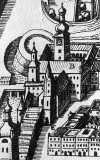16th century
Ferdinand I married Anna of Hungary in Linz in 1521. This wedding smoothed the way for a ‘Monarchia Austriaca’ after 1526.
The city also remained the preferred refuge of the court in case of epidemics (the plagues) and threats of war (above all the Turkish wars), but also served as an abode for members of the ruling family (Queen Katherina of Poland, Archduke Matthew).
The first beginnings of the reformation are to be seen in Linz after 1521. First it was the movement of the Anabaptists, who found craftsmen especially receptive.
The Lutherans put up their first mayor in 1542, and protestant preachers arrived in the 1670s. The Minorite monastry, which had gone under during the reformation, was handed to the craftsmen in 1562.
1598 - 1601
Start of the catholic counter-reformation in the city.
1582 - 1593
Archduke Matthew resides intermittently in Linz with his court.
1574
Transferral of the craft and protestant school from Enns to Linz; closure of this important school, at which a series of well-known scholars had worked, in 1625 during the counter-reformation, at which a series of well-known scholars worked.
1572
Flooding breaks through where the Ludl joins the Danube and forms a new arm of the Danube, later referred to as the Factory Arm. It is filled in as part of the efforts to regulate the Danube between 1889 and 1892.
1567 - 1572
Katharina of Poland (daughter of Emperor Ferdinand I) spends the last five years of her life in Linz Castle after being cast out by her husband, King Siegmund II, August of Poland.
1564 - 1571
Construction of the Landhaus by the craftsmen of the province upstream of the Enns.

1552
Diplomatic negotiation between Emperor Charles V and the protestant elector Moritz of Saxony in the run-up to the Contract of Passau.
1542
City fire.
1527 - 1562
Existence of a royal mint in Linz.
1527 - 1531
Bloody persecution of the Anabaptists, mainly represented by the craftsmen.
26th May 1521
Marriage of Archduke Ferdinand of Austria (Grandson of Emperor Maximilian I) to Anna of Hungary and Bohemia in Linz.
Since about 1520
Gradual spread of the Lutheran faith among inhabitants.
1509
City fire, after which a more representative town hall is constructed on the Main Square in 1513/1514.
Construction of an arsenal in the old town.
1502 - 1510
The royal central administration, known as the ‘Lower Austrian Regiment’, is located in Linz.
1501
Highest ever level of the Danube at Linz.